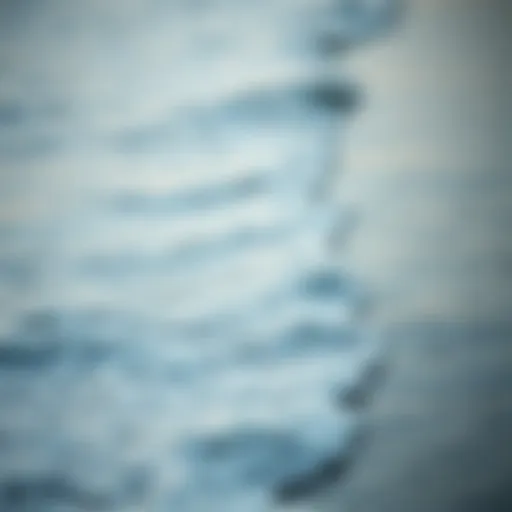Mastering Body Surfing with Hand Planes: Techniques & Tips
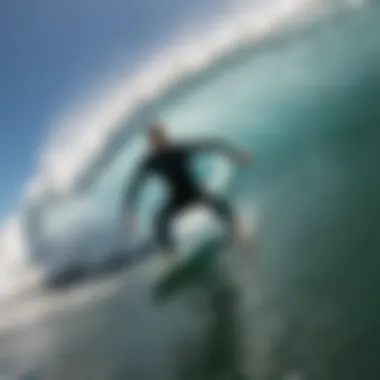

Intro
Body surfing, an age-old pastime of riding the waves with just your body, has recently seen a resurgence in popularity, particularly with the adaptation of the hand plane technique. Unlike traditional surfing, where boards are designed to aid paddling and riding, a hand plane is a minimalist tool that allows surfers to harness the power of the ocean in a unique and engaging way. This approach doesn't just cater to performance; it immerses you in the very essence of wave riding.
The origins of body surfing can be traced back to ancient cultures who rode waves using natural tools and their own bodies for recreation and transport. Fast forward to today, and there’s a thriving community around body surfing, celebrating everything from the skillful maneuvers through to the soul of ocean engagement. The hand plane acts as a bridge between simplicity and performance, enhancing the rider's experience without fluffing it up with excess gear.
In this exploration, we'll delve deep into the nuances of body surfing with a hand plane — from the gear and equipment needed, to the techniques that can enhance your experience in the water. Additionally, we’ll touch on safety practices that ensure not only a thrilling but also a responsible adventure amidst the surf.
Through this journey, the complex dance between man and ocean surfaces, showcasing why body surfing deserves a spot under the sun in the vast realm of water sports.
Prelims to Body Surfing
Body surfing is not just a sport; it’s an experience that connects the surfer with the ocean in an intimate and direct fashion. This practice elevates riding waves into an art form, emphasizing the body’s natural abilities without the interference of bulky equipment. In this article, we will explore the many facets of body surfing, particularly focusing on the hand plane technique, which has gained traction as an essential tool for enhancing performance on the waves.
Defining Body Surfing
At its core, body surfing is the act of riding waves using one's body without any board, relying solely on technique and intuition. It’s about feeling the water’s dynamics and letting the wave carry you. Unlike regular surfing which requires a board, body surfing allows for greater flexibility and a unique connection with the wave. This practice can be traced back to ancient Polynesian cultures, emphasizing its long-standing relevance in surf history.
Body surfing can be likened to dancing in water — each wave provides a new partner.
Whether it’s a gentle swell or a roaring surf, the thrill is in the ride. This simplicity exposes surfers to challenges and satisfaction that often transcend the experience of riding on a board. With just your hands and body, one is pushed to understand balance, timing, and the thrilling nature of the ocean. For those who seek an adventurous yet simple way to enjoy surf, body surfing stands as a compelling choice.
The Appeal of Riding Waves Without a Board
Riding waves without a board can be refreshing and alluring for several reasons.
- Direct Connection: Being in contact with the water creates a direct line to the ocean’s energy. You feel every ripple and swell, allowing for a more profound engagement with the environment.
- Minimal Gear: With no bulky boards to carry or manage, it allows surfers the freedom to explore more remote beaches and unexpected spots. Just throw on some swim trunks, grab your hand plane, and you’re good to go.
- Versatility: Body surfing is adaptable. It can be enjoyed in various wave conditions and locations, making it a year-round activity adaptable to different environments.
Moreover, riding waves without a board can also invoke a sense of nostalgia. It takes many back to childhood days spent splashing around at the beach, where laughter and joy came effortlessly. Thus, it is not just about the act itself, but also about savouring memories and creating new ones in the process.
The Hand Plane as an Essential Tool
In the realm of body surfing, the hand plane holds a unique position, playing a crucial role in enhancing the overall experience. It is not merely a piece of equipment but a significant extension of the surfer's body, allowing for greater maneuverability, speed, and control on the waves. This tool transforms a simple act of riding into a more immersive and dynamic experience.
The hand plane is designed to provide lift, reducing drag and allowing the surfer to glide smoothly across the surface of the water. This extra lift can make even small, gentle waves feel exhilarating, enabling surfers to ride longer and perform stylish maneuvers with ease. A well-crafted hand plane also enhances balance, letting surfers maintain a more stable position relative to the waves. The specificity of the hand plane’s shape and dimensions can vary, tailored to personal preferences and surf conditions. Thus, understanding these aspects is fundamental for both novices and seasoned surfers alike.
Understanding the Hand Plane
The hand plane is a simple yet effective tool that resembles a miniature surfboard or boogie board but is specifically designed to be held in one hand. Typically made from lightweight materials like foam or wood, it fits comfortably under the palm. To use it effectively, one must grip it firmly, using it as a propeller to catch waves and ride them more efficiently.
A larger plane can provide better lift, which is beneficial for bigger waves, whereas a smaller, lighter model might be suited for quick turns and sharp movements. Some surfers also customize their hand planes, giving them unique designs and colors that reflect their style. This customization adds an element of creativity to the sport, blending functionality with personal touch.
Here are some key elements to note:
- Size and Shape: Larger models offer more buoyancy while smaller ones allow for agility.
- Materials: Wood offers a traditional feel, while foam is more forgiving on the water.
- Grip: A comfortable grip is essential for maintaining control during rides.
Historical Context of Hand Planes in Surfing
Exploring the history of the hand plane reveals its deep-rooted significance in surf culture. The origins trace back to ancient Polynesian surfing rituals, where early surfers used wooden boards crafted for wave riding. The hand plane as we know it today evolved—with surfers experimenting with size and material to maximize performance.
In the 1970s and 1980s, the hand plane gained momentum as a favored tool among body surfers. It became a symbol of innovation in the surfing community, transforming how enthusiasts approached wave riding. While big boards gained popularity, hand planes celebrated a renaissance as surfers sought a more stripped-back experience that felt closer to the ocean, maintaining the purity of catching waves.
"The hand plane is not just equipment; it's an emblem of the connection between the surfer and the ocean. It’s about feeling the water and becoming one with the wave."
Over time, artists and builders began to embrace the craft of creating hand planes, leading to a thriving market where both functional art and surfing collide. This evolution mirrors the overarching surf culture's growth, reflecting values of creativity, sustainability, and a deep respect for nature. Today, hand planes are manufactured by various brands, each bringing their flare into the bustling world of body surfing.
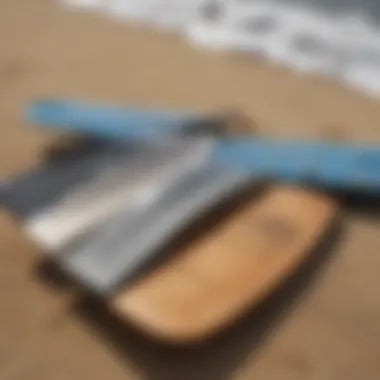

In summary, the hand plane serves both practical and cultural purposes in body surfing—it enhances performance while connecting a surfer to rich traditions of wave riding.
Mechanics of Body Surfing with a Hand Plane
When it comes to body surfing, especially with the use of a hand plane, knowing the mechanics is absolutely vital. This isn't just about paddling out and catching waves; it's essentially about developing a harmonious connection with the water. By honing in on the mechanics, surfers can wield the hand plane to enhance their overall experience in the ocean—whether you're a newcomer or a seasoned veteran.
Correct Stance and Positioning
Getting your body into the right stance is one of the first things to nail down. Picture this: you’re on the beach, hand plane in tow, staring down the horizon where the waves begin to swell. The first thing you ought to consider is your positioning on the hand plane. When lying down, your chest should rest on the board, arms extended forward gripping the front of the plane.
Your body should be streamlined, extending your legs back. You want to minimize drag to maximize speed—think of it like a torpedo gliding through water. It's also key to keep your head slightly raised; this will help you to scan for incoming waves. The slight tilt of your head can make a world of difference in controlling your speed.
- Key Points for Stance:
- Head Position: Slightly elevated for wave observation.
- Arm Placement: Extended and firm—gripping the hand plane.
- Body Alignment: Flat and streamlined to reduce drag.
Paddling Techniques for Optimal Speed
Paddling is the engine that propels your body through the waves. The tricky aspect is that it requires a mix of technique and rhythm. Instead of flailing around like a flounder, think smooth and deliberate movements. Begin by engaging your core while making broad, sweeping motions with your arms. This isn't a sprint; you want to find your rhythm.
The positioning of your hands on the hand plane plays a pivotal role. Focus on moving both arms in unison but allow your wrists to flick slightly downward as you pull water back. It’s a bit like rowing a boat, where you want to take full advantage of your arm strength while keeping a rhythm that allows you to conserve energy.
- Tips for Effective Paddling:
- Engage Core Muscles: Helps with stability and strength.
- Flick Your Wrists: Adds propulsion with less effort.
- Synchronize Arms: A smooth, rhythmic motion is key.
Wave Selection and Timing
When riding waves with your hand plane, not all waves are created equal. Understanding which waves to ride and when to catch them is pivotal for an exhilarating experience. It’s crucial to recognize the right moment, as proper timing determines whether you’re going to ride high or get swallowed by the wave.
Look for waves that have a nice peak—these are typically more suited for body surfing with a hand plane. Keep your eyes peeled for waves that haven't fully broken yet; catching them early can afford you a longer ride.
- How to Choose the Right Wave:
- Watch for the Peak: It indicates the wave’s potential.
- Observe Others: Witness how others ride to gauge the best moments.
- Timing is Everything: Launch yourself just before the wave breaks.
"Timing is as crucial as the waves themselves; it can make or break your ride. Learn to read the ocean, and you’ll be riding waves like you were born to do it."
In summary, each element—your stance, paddling technique, and wave selection—intertwines to create an effective and enjoyable body-surfing experience with a hand plane. Mastering these mechanics can turn a simple wave ride into a thrilling adventure. With practice, patience, and a little intuition, body surfing can transform into a cherished form of expression and joy.
Advanced Hand Plane Techniques
When it comes to body surfing, utilizing a hand plane can transform the experience from a casual ride to an exhilarating dance on the waves. Advanced hand plane techniques go beyond just catching a wave; they delve into a realm of artistry and skill that enhances both performance and enjoyment. These techniques allow surfers to interact more dynamically with the surf, carving through water and even launching aerials, which presents both new challenges and thrilling opportunities.
By honing these advanced skills, surfers not only improve their performance but also deepen their connection to the ocean. Mastering these techniques lends itself to a better understanding of water dynamics, fostering a greater appreciation for the natural environment while engaging with it playfully.
Buttering and Carving
Buttering refers to the smooth technique of transitioning from one turn to another, often described as gliding seamlessly along the crest of a wave. This technique allows body surfers to manipulate the hand plane's surface and change direction effortlessly, creating fluid movements that feel almost like surfing on air. A key element of buttering is to maintain an appropriate body posture; keeping the knees slightly bent while leaning forward will provide better stability and control.
Here are some points to consider when practicing buttering:
- Wave selection is crucial: Opt for waves with less steepness at their peak, ensuring that you can maneuver without losing speed.
- Identify your center of gravity: Keeping a low center of gravity affords better balance and helps in making smoother turns.
- Practice shifting weight: Moving your weight from your back foot to your front foot can create the necessary thrust during turns.
Carving is another level up from buttering. It involves deep, sweeping turns that mimic traditional surfing but, in this case, is performed with just the body and a hand plane. This technique is vital for gaining speed and maintaining momentum. To carve effectively, a surfer needs to engage their core muscles and keep fluid movements in thier limbs.
Aerial Maneuvers and Tricks
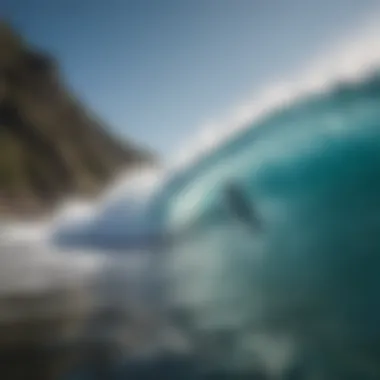

Once a surfer has gained proficiency in buttering and carving, the next natural progression involves adding aerial maneuvers into their repertoire. These jumps and tricks can elevate the experience to new heights—literally.
Aerial maneuvers require a solid understanding of timing and wave dynamics. Here’s how to get started:
- Pick the right wave: Look for waves with enough height and power to provide lift as you approach for takeoff. Peaky waves often present the best opportunities for aerial tricks.
- Commit to the jump: When you feel the wave lifting you, commit to the maneuver. Hesitation can result in missed opportunities or tumbles.
- Keep your body tight: While you’re in the air, tuck your knees close to your chest. This not only helps with balance but also prepares you for landing without losing speed.
- Practice landing techniques: Try to land on the tail of the hand plane, absorbing the impact with your knees.
"Aerial maneuvers, when executed impeccably, turn the already captivating experience of body surfing into a breathtaking display of skill and artistry."
Incorporating advanced hand plane techniques like buttering, carving, and aerial maneuvers enriches the experience and enhances the joyful pursuit of riding waves. Surfers who embrace these practices elevate their connection to the ocean and enjoy the rewards of each successful carve and leap.
Preparation and Safety Considerations
Before you catch a wave with your hand plane, it's crucial to lay the groundwork for a safe and enjoyable experience. Understanding the environment and the conditions of the water can make the difference between a fabulous session and a potentially dangerous situation. Body surfing, while exhilarating, does come with its share of risks, especially when people rush into the water without a second thought. So, how do we prepare and ensure our safety?
Assessing Conditions Before Entering the Water
First and foremost, one must play the role of a weather observer. Each surf session starts before you even step onto the sand. You need to check the surf report, which provides vital information on wave height, tide schedules, and wind conditions. Knowing whether you are facing a gentle swell or turbulent waters can tip the scales in your favor.
- Look at wave size and frequency. Smaller, rolling waves can be perfect for beginners, while larger, fast waves may be suited for those with more experience.
- Pay attention to tide changes. Tides influence how the waves break and can reveal hazards that lie hidden during low tide.
- Consider wind conditions—light offshore winds are often ideal as they help preserve the shape of the wave.
You might even want to watch the waves for a while before going in. This can provide insights into patterns that develop, like how they break or where the strong currents pull. A seasoned surfer tends to spend a few minutes studying the ocean before taking the plunge. In the end, having this awareness can significantly diminish risks while enhancing the pleasure of your time in the water.
Recognizing Potential Hazards
Regardless of your skill level, awareness of hazards is paramount. The water has its unseen dangers that can quickly turn an adrenaline rush into a scary moment. Here are several hazards to be mindful of:
- Rip Currents: Often, these pull powerful streams of water away from the shore. Look for areas where the water appears choppy or dirty, and avoid swimming directly against them. If you get caught, try swimming parallel to the shore until you're free of the current.
- Rocky Terrain and Reefs: Understanding your surroundings is vital. Some beaches hide rocks just beneath the surface, particularly at low tide. An errant wave can send you tumbling onto these jagged edges.
- Marine Life: It’s not only humans you contend with. Jellyfish and sharp-toothed fish can pose issues. If in doubt about the local fauna, it’s wise to do a quick research check. Even a small encounter can lead to discomfort and injury.
"Staying aware of your environment and respecting it isn’t just about keeping yourself safe; it’s about fostering a deeper connection to the ocean."
Remember, preparation isn’t just smart; it’s essential. The more informed you are about the conditions and potential hazards, the more likely you'll have a thrilling yet safe experience body surfing with your hand plane.
Cultural Significance of Body Surfing
Body surfing, through its graceful simplicity, taps into a deep well of cultural significance that has evolved over decades. Surfers from various backgrounds share a bond through the waves, each culture bringing its own traditions and styles. The hand plane has come to represent not just a tool, but a gateway into a broader community of enthusiasts, embodying the spirit of fun and adventure. Understanding its cultural relevance adds layers to the experience, offering context for those who glide along the water.
The Evolution of Surf Culture
Surf culture has metamorphosed astonishingly since its inception. Initially, surfing was steeped in the rituals of Hawaiian kings, where it symbolized status and power. The introduction of body surfing brought with it a more accessible approach to riding waves, allowing everyone to partake regardless of skill or access to expensive boards. The hand plane is a nod to this evolution, marrying tradition with modern innovation, and forming an inclusive bridge across generations.
As surfing expanded beyond Hawaii, diverse geographic regions adopted and adapted the practice, leading to unique interpretations of wave riding. The body surfing community, in particular, is often characterized by its lack of pretentiousness, drawing enthusiasts not just from coastal cities but from all walks of life. With the rise of social media, platforms like Facebook and Reddit serve as hubs for enthusiasts to share their stories, techniques, and achievements, weaving a richer narrative of this cultural phenomenon.
Community and Connection Among Surfers
The sense of belonging that arises within the body surfing community is profound. It’s not merely about catching waves; it’s about collecting shared experiences, building friendships, and forming connections that span cultures and continents. Many seasoned surfers often recount the thrill of welcoming a newcomer into the lineup, an unspoken rite that fosters camaraderie and mentorship.
"When you hit the water, all barriers come down; it’s just you, the ocean, and fellow surfers passing on knowledge."
The act of body surfing with a hand plane elevates this experience further. The simplicity of the tool encourages surfers to embrace the moment. Whether in a crowded lineup or a secluded cove, the joy of riding waves equates to a universal language that transcends cultural differences. Keeping this practice alive ensures that the heart of surfing remains rooted in connection, a value that has only grown in importance in our increasingly digital world. As the community continues to thrive, the hand plane serves as a reminder of the sport’s rich history and the shared joy it brings.
Environmental Considerations
The practice of body surfing, especially with a hand plane, brings an unpredictable but thrilling connection between surfer and nature. However, as the waves tempt us with their allure, it’s imperative to take a step back and consider our impact on the environment. The vibrant ecosystems that form around coastal areas are not only beautiful but also crucial for marine biodiversity. Protecting these spaces can ensure that future generations of surfers experience the same joys we do today.
Sustainable Practices in Surfing
Engaging in sustainable practices is more than a passing trend; it's a responsibility that every surfer should embrace. Here are a few pivotal strategies:
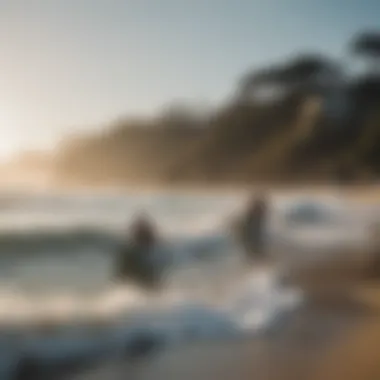

- Choose Eco-Friendly Equipment: Opt for hand planes made from sustainable materials, such as recycled plastics or responsibly sourced wood. Brands like Corky’s Boards offer an array of eco-conscious options.
- Mind Your Waste: Always bring a reusable water bottle and minimize single-use plastics. After a day of surfing, take the time to clean up any trash left on the beach; every piece picked up counts.
- Educate and Advocate: Share your knowledge about sustainable surfing practices within your community. Encourage friends to adopt eco-friendly habits in their lifestyle.
- Support Local Conservation Initiatives: Many regions have organizations that work on protecting marine environments. Your involvement or donations can go a long way.
Impact of Climate Change on Surf Spots
Climate change, unfortunately, isn't just an abstract notion; it's a palpable reality that directly affects surf conditions. As temperatures rise, several critical changes have been observed:
- Shifting Wave Patterns: Changes in weather patterns would result in altered wave formations. What was once a reliable surf spot may no longer provide optimal conditions due to variances in wind and water temperature.
- Rising Sea Levels: Coastal erosion and habitat loss are becoming more commonplace. Areas that were previously safe for surfers can become hazardous spots where beaches shrink or disappear altogether.
- Decreasing Water Quality: The rise in ocean temperatures can lead to more harmful algal blooms. Water tainted with such blooms can pose serious health risks for surfers who come into contact.
- Changes in Marine Life: As habitats shift, certain marine species may migrate to other areas, affecting the overall ecosystem balance.
As surfers, we must become increasingly aware of these environmental challenges. Our actions can influence the state of our coastlines, and it’s in our best interest to champion sustainability in our beloved sport. Protecting our surf spots will not only allow us to continue enjoying the thrill of body surfing but also preserve the natural beauty that accompanies it.
"Our ocean is our playground, but we are the caretakers of its health."
Resources for Body Surfers
When diving into the world of body surfing, especially with a hand plane, having the right resources at your fingertips can make all the difference. These tools can guide both novices and seasoned surfers as they navigate the waves. From proper gear to knowledge-sharing platforms, each element unfolds a layer of depth to the experience, allowing surfers to engage more meaningfully with this sport.
The importance of resources chimes well into the broad appeal of body surfing. With the rise of online communities and specialized shops, aspiring surfers can rapidly access information and equipment tailored to their needs. This ecosystem not only promotes safety and enjoyment but also fosters a sense of belonging, vital to succeeding in such an experiential sport.
Where to Purchase Hand Planes
When it comes to selecting a hand plane, quality matters. Being able to find the right one terms not only the shape and size but also the materials used in its construction. Some brands have carved a niche in the market, such as Duh and Dawn Patrol, both widely respected for their craftsmanship. These companies often offer a range of hand planes, catering to different skill levels and wave conditions.
For those who prefer a more personalized touch, local surf shops can also be a great option. They typically have knowledgeable staff who can help guide purchasing decisions based on individual preferences and local wave conditions. Additionally, experimenting with second-hand hand planes can be beneficial, as they often come with a history that newer versions lack.
The advantages of these options are clear:
- Support Local Businesses: Choosing local shops strengthens grassroots surf culture.
- Informed Choices: Staff can provide tailored advice on gear best suited to one’s surfing style.
- Budget-Friendly: Second-hand options can save money while still offering quality experiences.
Online Communities and Instruction
In the digital age, online communities have exploded as platforms for knowledge transfer and connection among surfers. Places like Reddit and Facebook boast groups where enthusiasts share tips, videos, and personal stories. Participating in these communities can offer an invaluable resource to hone one’s skills through observations and advice from experienced surfers.
Instructional content is also proliferating across various platforms. YouTube has become a treasure trove for aspiring body surfers, where numerous channels cater specifically to hand planing. Here, one can find everything from beginner tutorials to advanced techniques.
Benefits of tapping into these online resources include:
- Diverse Perspectives: Learning from surfers with different experiences enhances one’s technique.
- Safety Tips: Communities often share important safety considerations and environmental awareness.
- Instant Feedback: Posting videos or questions allows surfers to receive timely advice and corrections.
Engaging with fellow body surfers, both in-person and online, cultivates a welcoming space filled with encouragement and shared passion. Whether finding the perfect hand plane or learning the nuances of technique, these resources support a thriving body surfing culture.
Finale: Embracing the Simplicity of Body Surfing
In a world where complexity often masks the simple joys of life, body surfing, especially with the aid of a hand plane, stands out as a refreshing alternative. The ease of connection to nature and the sheer pleasure of riding waves remind us of what it means to play in the ocean without the constraints of bulky equipment. Rather than being a sport defined by high-tech gadgets or flashy moves, body surfing champions the straightforward, almost childlike thrill of catching a wave, freeing us from the many factors that can complicate the surfing experience.
By floating along the surface, the rider becomes a part of the environment. Every wave presents a new challenge, and mastering the use of a hand plane only amplifies the experience. This simplicity not only encourages a deeper engagement with the ocean but also fosters a sense of community among fellow surfers who share similar experiences. The experience has the potential to transcend mere sport; it's a rite of passage through which many find camaraderie, respect for the sea, and a personal sense of peace.
Reflecting on the Joy of Riding Waves
There’s a unique joy that comes from riding waves without a surfboard, a feeling that captures the essence of body surfing. It’s not just about the thrill; it's about being in tune with the ocean’s rhythms. As the water lifts you, there’s a blend of exhilaration and serenity that’s difficult to describe. Each wave feels like a conversation with the sea, one that teaches patience, timing, and balance.
"Riding a wave is not merely about control, but rather about harmony with the water."
Experiencing the ocean this way can induce a meditative state, where the physical act of body surfing transforms into a celebration of movement and freedom. Each ride speaks a different story, based on the wave's shape and power, which enriches the experience. Many surfers describe the feeling akin to flying - weightless and entirely in sync with the flow of the water. This experience hooks many, drawing them closer to the ocean and solidifying their passion for body surfing.
Encouraging New Surfers to Experience Hand Planing
For those on the fence about trying body surfing or hand planing, there really isn’t much to lose. The barrier to entry is remarkably low—no need for special boards or expensive gear. All one requires is a hand plane and a willingness to be in the water. It’s a wonderful way to dive straight into surfing, particularly for beginners who may find traditional surfing daunting.
Being a part of a vibrant surf community means countless opportunities to learn and share experiences. Online forums and local surf groups are places where advice on technique, local conditions, and shared stories flow freely. Connecting with those who share the same passion enhances not only individual abilities but also the culture of body surfing.
Encouragement is essential: those who dare to give it a shot will find themselves welcomed with open arms. Many seasoned surfers are eager to share tips, tricks, and their own tales, creating an atmosphere that nurtures growth and enjoyment. There’s an incredible feeling of fulfillment when someone catches their first wave, a moment to cherish and inspire others.
In wrapping this up, it's crucial to remember that body surfing—especially with a hand plane—is about embracing simplicity while still experiencing the profound connection to nature. So, grab a hand plane, get in the water, and see where the waves take you.







